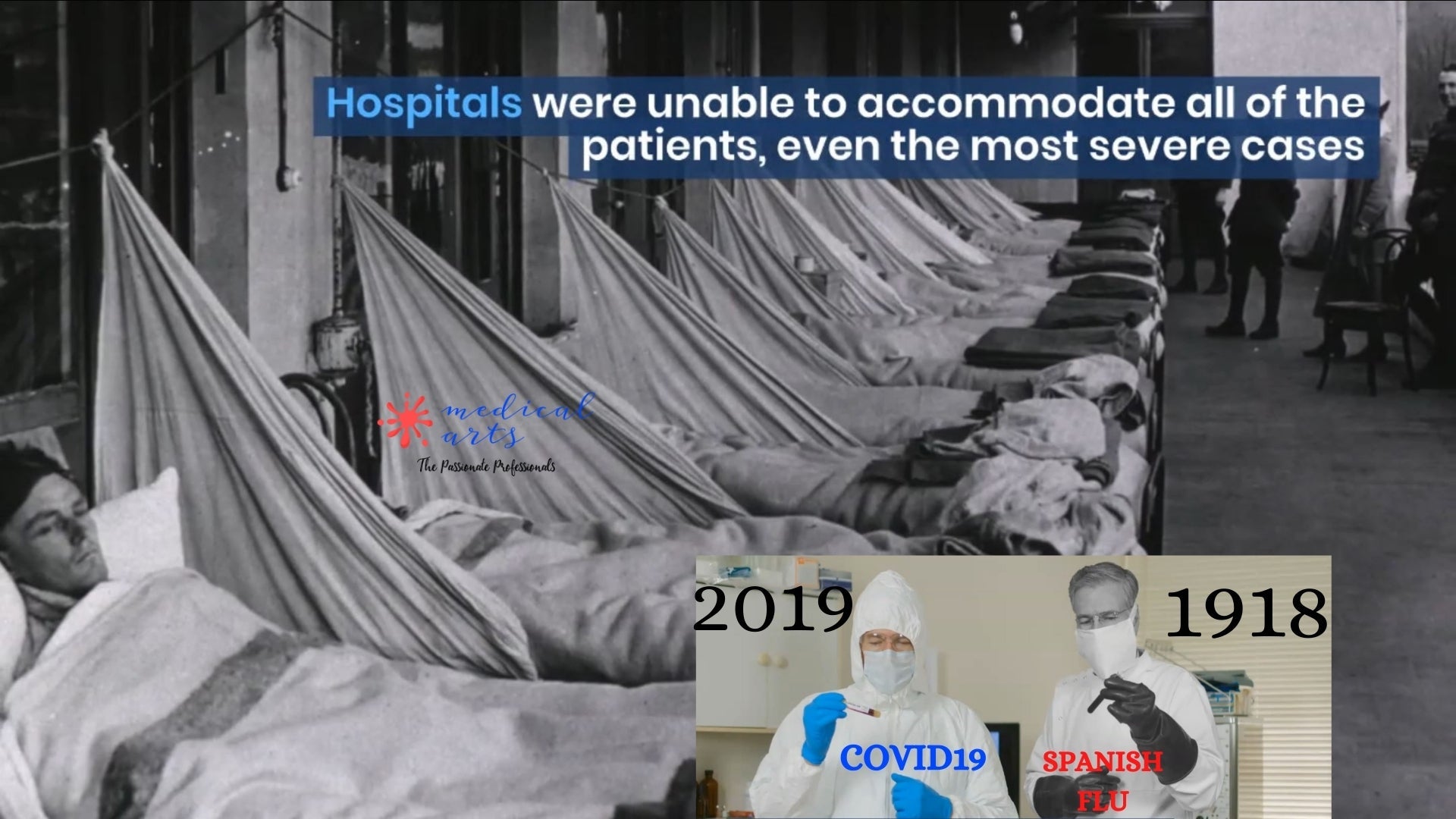A century apart two pandemics caused by flu viruses, what are the similarities and differences that have changed in 100 years?
Below you can find the scripts to our youtube video Spanish flu (1918) vs COVID 19 (2019)
As we enter the second year of a World Pandemic Marathon
It is worth reminding ourselves of the Spanish flu between 1918–1920.
There were three waves of the "Spanish flu" that infected 500 million people, accounting for one-third of the world's population.
In the spring of 1918, the first wave was regarded as mild, with a mortality rate not unusually high.
This period witnessed WWI that involved traveling millions of troops, which contributed to the spread of the virus across the oceans.
The second wave spread from France to England and then on to Spain.
Where it killed eight million people and became known as the Spanish flu
A unique feature about this infection is that nearly half of the deaths worldwide were in the healthy 20–40 year old age group.
During the last four months of 1918, the United States reported 380,996 deaths.
The third wave in early 1919 was less severe, but the age distribution of deaths was similar.
The number of deaths was estimated to be at least 50 million worldwide.
A report by the Paris Medical Academy for the prevention of influenza was published in 1918.
It consisted of personal hygiene measures, as mouthwashes.
Gargle twice a day with a glass of warm water added with a solution of chlorinated soda.
Prevention of overcrowding, washing, and disinfection of tramways and railways carriage, school closure.
Since there was minimal understanding of influenza and no antiviral medications to slow its progression,
therapies, such as Vicks VapoRub, aspirin, cough medicines, clean linen, ventilation, and hot soup were often prescribed.
Hospitals were unable to accommodate all of the patients, even the most severe cases
100 years later.
In December 2019.
There were reports of pneumonia clusters of an unknown cause at health facilities in Wuhan, China.
Initially, these cases were linked to a wet animal wholesale market in the region.
Investigations identified a novel coronavirus.
The outbreak quickly expanded locally and globally with large outbreaks.
On January 21st, 2020, the United States had its first confirmed case.
On March 11th, 2020, the WHO announced the coronavirus pandemic as an "International Public Health Emergency of International Concern."
This was only the sixth time in history a global health emergency had been declared.
We are not in a very different situation than in another period of our history when we managed the Spanish flu to face this pandemic.
We do not know this virus, the characteristics of its disease, which drugs might give relief to patients!!
We started relying on preventive measures as Physical distancing.
Face masks To measure body temperature at the entrance of closed areas.
To ensure disinfection rules in public contests as transports, shopping areas, schools, universities.
Hand hygiene
To protect healthcare workers with appropriate Personal Protection Equipment (PPE).
Laboratories, research centers, and private industries have stepped forward to reduce this impact by investigating ways to slow the spread and finally by producing vaccines against some strains.
In our century, there are vaccines to prevent a variety of influenza strains.
Antiviral drugs to treat some flu illnesses, antibiotics to control some complications
In both pandemics, there was a lack of global preparation and plan.
As we examine the Spanish flu and COVID-19 pandemics, it is evident.
There are lessons to be brought forward to manage the next pandemic better.
Both diseases were caused by viruses, extremely contagious with high mortality,
Both spread by breathing and by contact with contaminated surfaces.
Since the 1918–1919 pandemic, there has been a century to study the origins of influenza strains, Which have created 7 pandemics in 100 years
Rather than concentrating on when it will occur, we need to focus on the valuable lessons and carry them forward to future global disease outbreak preparation.
Of course, the current availability of technology has made and continues to make a difference.
Several strategies, such as health education, isolation, hygiene, and surveillance,
have improved our knowledge of influenza transmission,
Learn more about the human body and related topics: https://bit.ly/3eZjCSi
If you like our video, consider subscribing to our channel.
In this video, you will find answers to the following questions:
What is the Spanish flu?
When did the Spanish flu?
How many waves happened during the Spanish flu pandemic?
How many people were infected by the Spanish flu?
How many people died because of the Spanish flu?
What contributed to the spread of the Spanish flu in 1918?
What happened during the second wave of Spanish flu? How many people died from Spanish flu in Spain?
What age group was most affected by the Spanish flu?
How did they treat people who caught the Spanish flu?
A report by the Paris Medical Academy for the prevention of influenza was published in 1918. What did the recommendations consist of?
When did COVID 19 / Coronavirus start? Where did COVID-19 start?
When was the first case of coronavirus declared in the united states?
What date did the world health organization (WHO) declare an international public health emergency?
How many times in history has a global health emergency been declared?
What are the differences between COVID 19 / coronavirus and the Spanish flu?
How was COVID-19 handled?
What measures were taken to control it?
What are the similarities between the Spanish flu and COVID 19?
What difference did the Laboratories, research centers, and private industries face the COVID 19 pandemic?
What type of medicines are used to treat the coronavirus?
What are our lessons from both pandemics?
What should we do next?

